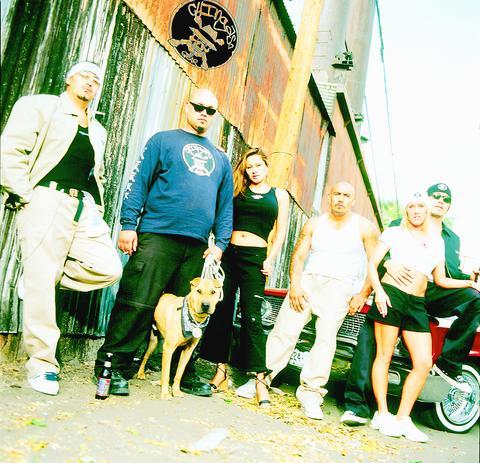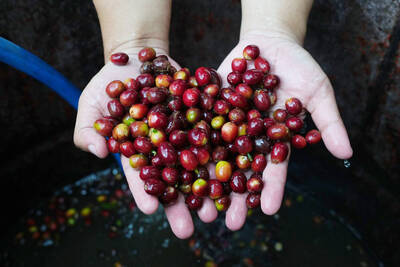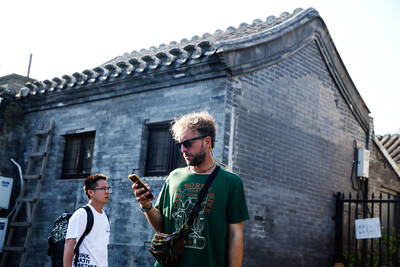Patricio Gasia, 20, flaunts his own brand of street cred, one part hip hop two parts cholo, which is slang for the Mexican-American gangster style that originated in East Los Angeles. His street-tough look, a composite of oversize T-shirt, visored cap and pastel-tinted rosary, was enhanced by his bicycle, a low and streamlined trick bike, customized with baroque metallic flourishes.
Gasia, a busboy who works in Spanish Harlem, spoke last week through a friend and interpreter. His style "comes from people of color but with a Latino twist," he said. The idea is to look, he said, "chingaso -- ready to fight, like a gangster."
Gasia is among a wave of young Mexican-Americans in New York who have imported the east Los Angeles outlaw look, though not necessarily the lifestyle, from California.

In cities across the US, young Latino men and some women are picking up on the same trend, incorporating elements of cholo into their street garb, conferring on the style an authenticity that commends it to the would-be hip.
"Cholo is definitely bubbling under in a big way," said Rodrigo Salazar, the editor in chief of Urban Latino, a magazine for young Hispanics. Adopting its provocative insignia -- low-slung chinos, bandannas folded low on the head and florid religious tattoos -- is a way for some young Latinos to register pride and to stake a claim on their own culture, Salazar said. And lately some of those gritty elements have seeped into the fashion vernacular of non-Latinos as well.
New York University undergraduates swagger down lower Broadway affecting diluted variations: neatly folded bandannas, T-shirts emblazoned with the Virgin of Guadalupe and "Mi Vida Loca" slogans printed in ornate gothic letters, pants cropped at calf length or shorts worn with white socks pulled up to the knees.
On Christopher Street, weekend revelers club-hop with their trousers festooned in chains, their buzz cuts all but obscured by cholo-style hats or "brims," characteristically creased once at the center and turned down at the rim.
And now the street-based style is percolating up to highly visible pop stars and to mainstream retailers like the Gap and Henri Bendel. Missy Elliott and Christina Aguilera have adopted bandannas and cholo hats in their stage outfits. Cher appeared on the celebrity TV news program Access Hollywood last week in a salon-slick variation of chola braids. The Gap's nod to cholo is a popular line of monogrammed jeans and corduroy pants embroidered Latino style in gothic letters, as modeled by Madonna.
"This trend feels exactly like rap and hip hop culture did in the early 1980s, and it's likely to follow the same trajectory," predicted Irma Zandl, a partner in the Zandl Group, a trend consulting company in New York.
Fueling it is a shift in demographics. Hispanics are now the largest minority group in the US, the last census data show. And Hispanic Americans 18 to 24 years old are the fastest-growing segment of the US population, more than 60 percent of them of Mexican descent. Given the expanding cultural clout of Latinos, it is not surprising that east Los Angeles street style is crossing over.
Music is the main avenue for its spread, both to Hispanics and non-Hispanics. Stations that broadcast Latino rock, like Power 106 in Los Angeles, feature Latin hip hop or rap groups like Spanish Fly, Psycho Realm and Delinquent Habits. The newest video by the heavy-metal band Metallica, St. Anger, is set in a Los Angeles jail, the camera zooming in on inmates who display chinos and assorted tattoos.
As with hip hop and punk before, it is a fascination with the grittier side of life that makes cholo style alluring to fashion followers.
"We began to see it on the streets about two years ago, but now, what's weird is that you are starting to see it on housewives," said Ed Burstell, general manager of Henri Bendel, the Manhattan emporium, who last week made a trend-scouting expedition to Los Angeles that included a visit to the east side barrios. "You start to see elements of cholo in specialty stores on Robertson and Montana," Burstell said, referring to fashionable shopping streets on the west side of Los Angeles. "The bigger story is that cholo really is the next wave."
Others are more tentative. "I'm seeing a little of that cholo look mixed in with hip hop -- the crosses, the bandannas worn low, the wallet chains, the tattoos and religious icons," said Kal Ruttenstein, the fashion director of Bloomingdale's.
The style derives additional clout from pop divas like Gwen Stefani, whose new fashion brand, L.A.M.B., is infused with cholo references -- homage to her Orange County roots, she said. Her line offers form-fitting tank tops, gaucho pants, T-shirts and even tailored jackets decorated with chains and embroidered with cholo's characteristic gothic lettering. (Why such script is favored is obscure, though it dates back at least 50 years to the zoot-suit era.) "We were going for a definite inner-city vibe," said Annie Younger, who collaborated with Stefani in designing the line.
Chingaso Gear, a new Denver-based sportswear company, makes no secret of the genesis of its look. "It's Los Angeles street tough," said Craig Pe, a partner in the company. "But we're not really going for a gangster look. We use the term `chingaso' more to refer to a struggle, the battle we go through in our daily lives."
The company has sought to market its street, gym and boxing apparel not through music but in the ring, on professional fighters like Johnny Tapia, Oscar De La Hoya and Fernando Vargas. Last February, it displayed its wares at Magic, an influential trade show for youth-oriented sportswear in Las Vegas.
Come spring, Rogan, a New York sportswear company with a trend-besotted following, will market T-shirts printed with Roman Catholic religious imagery and messages like "Live and Let Live" printed in gothic letters, some to be sold at Barneys New York. "I do love cholo," said Rogan, the company's owner and designer. "It's very clean and kind of minimal."
Rafael Jiminez, the founder and owner of Republica Trading, a Latino-inspired urban line sold at Bloomingdale's, has likewise dipped into the cholo well. Among the influences Jiminez has explored for his fall 2004 collection are gothic letters and camouflage military jeep caps. "That's our way of giving props -- respect -- to the West Coast," he said.

Climate change, political headwinds and diverging market dynamics around the world have pushed coffee prices to fresh records, jacking up the cost of your everyday brew or a barista’s signature macchiato. While the current hot streak may calm down in the coming months, experts and industry insiders expect volatility will remain the watchword, giving little visibility for producers — two-thirds of whom farm parcels of less than one hectare. METEORIC RISE The price of arabica beans listed in New York surged by 90 percent last year, smashing on Dec. 10 a record dating from 1977 — US$3.48 per pound. Robusta prices have

A few years ago, getting a visa to visit China was a “ball ache,” says Kate Murray. The Australian was going for a four-day trade show, but the visa required a formal invitation from the organizers and what felt like “a thousand forms.” “They wanted so many details about your life and personal life,” she tells the Guardian. “The paperwork was bonkers.” But were she to go back again now, Murray could just jump on the plane. Australians are among citizens of almost 40 countries for which China now waives visas for business, tourism or family visits for up to four weeks. It’s